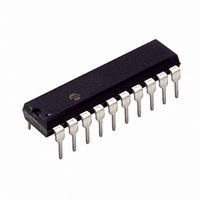PIC16C770-I/P Microchip Technology, PIC16C770-I/P Datasheet - Page 73

PIC16C770-I/P
Manufacturer Part Number
PIC16C770-I/P
Description
IC MCU CMOS A/D 2K 20MHZ 20-DIP
Manufacturer
Microchip Technology
Series
PIC® 16Cr
Datasheets
1.PIC16C770-ISO.pdf
(220 pages)
2.PIC16C770-ISO.pdf
(6 pages)
3.PIC16C770-ISO.pdf
(8 pages)
Specifications of PIC16C770-I/P
Core Size
8-Bit
Program Memory Size
3.5KB (2K x 14)
Oscillator Type
Internal
Core Processor
PIC
Speed
20MHz
Connectivity
I²C, SPI
Peripherals
Brown-out Detect/Reset, POR, PWM, WDT
Number Of I /o
15
Program Memory Type
OTP
Ram Size
256 x 8
Voltage - Supply (vcc/vdd)
4 V ~ 5.5 V
Data Converters
A/D 6x12b
Operating Temperature
-40°C ~ 85°C
Package / Case
20-DIP (0.300", 7.62mm)
Controller Family/series
PIC16C
No. Of I/o's
16
Ram Memory Size
256Byte
Cpu Speed
20MHz
No. Of Timers
3
No. Of
RoHS Compliant
Core
PIC
Processor Series
PIC16C
Data Bus Width
8 bit
Maximum Clock Frequency
20 MHz
Data Ram Size
256 B
Data Rom Size
256 B
On-chip Adc
6 bit
Number Of Programmable I/os
16
Number Of Timers
3 bit
Operating Supply Voltage
2.5 V to 5.5 V
Mounting Style
Through Hole
Height
3.3 mm
Interface Type
I2C, SPI, SSP
Length
26.16 mm
Maximum Operating Temperature
+ 85 C
Minimum Operating Temperature
- 40 C
Supply Voltage (max)
5.5 V
Supply Voltage (min)
4 V
Width
6.35 mm
Lead Free Status / RoHS Status
Lead free / RoHS Compliant
For Use With
DVA16XP200 - ADAPTER ICE 20DIP/SOIC/SSOPAC164028 - MODULE SKT PROMATEII 20SOIC/DIP
Eeprom Size
-
Lead Free Status / Rohs Status
Details
Other names
PIC16C770I/P
When the application software is expecting to receive
valid data, the SSPBUF should be read before the next
byte of data to transfer is written to the SSPBUF. Buffer
full bit, BF (SSPSTAT<0>), indicates when the SSP-
BUF has been loaded with the received data (transmis-
sion is complete). When the SSPBUF is read, bit BF is
cleared. This data may be irrelevant if the SPI is only a
transmitter. Generally the MSSP Interrupt is used to
determine when the transmission/reception has com-
pleted. The SSPBUF must be read and/or written. If the
interrupt method is not going to be used, then software
polling can be done to ensure that a write collision does
not occur. Example 9-1 shows the loading of the SSP-
BUF (SSPSR) for data transmission.
EXAMPLE 9-1:
The SSPSR is not directly readable or writable, and
can only be accessed by addressing the SSPBUF reg-
ister.
(SSPSTAT) indicates the various status conditions.
FIGURE 9-2:
LOOP BTFSS SSPSTAT, BF
2002 Microchip Technology Inc.
Additionally, the MSSP STATUS register
BSF
GOTO
BCF
MOVF
MOVWF RXDATA
MOVF
MOVWF SSPBUF
STATUS, RP0
LOOP
STATUS, RP0
SSPBUF, W
TXDATA, W
SPI Master SSPM<3:0> = 00xxb
MSb
Loading the SSPBUF
(SSPSR) Register
SPI MASTER/SLAVE CONNECTION
PROCESSOR 1
Serial Input Buffer
Shift Register
(SSPBUF)
(SSPSR)
;Specify Bank 1
;Has data been
;received
;(xmit complete)?
;No
;Specify Bank 0
;Save SSPBUF...
;...in user RAM
;Get next TXDATA
;New data to xmit
LSb
Advance Information
SDO
SCK
SDI
Serial Clock
9.1.2
To enable the serial port, MSSP Enable bit, SSPEN
(SSPCON<5>) must be set. To reset or reconfigure SPI
mode, clear bit SSPEN, re-initialize the SSPCON reg-
isters, and then set bit SSPEN. This configures the
SDI, SDO, SCK and SS pins as serial port pins. For the
pins to behave as the serial port function, some must
have their data direction bits (in the TRIS register)
appropriately programmed. That is:
• SDI is automatically controlled by the SPI module
• SDO must have TRISB<5> cleared
• SCK (Master mode) must have TRISB<2>
• SCK (Slave mode) must have TRISB<2> set
• SS must have TRISB<1> set, and ANSEL<5>
Any serial port function that is not desired may be over-
ridden by programming the corresponding data direc-
tion (TRIS) register to the opposite value.
9.1.3
Figure 9-2 shows a typical connection between two
microcontrollers. The master controller (Processor 1)
initiates the data transfer by sending the SCK signal.
Data is shifted out of both shift registers on their pro-
grammed clock edge, and latched on the opposite
edge of the clock. Both processors should be pro-
grammed to same Clock Polarity (SSPCON<4>), then
both controllers would send and receive data at the
same time. Whether the data is meaningful (or dummy
data) depends on the application software. This leads
to three scenarios for data transmission:
• Master sends data — Slave sends dummy data
• Master sends data — Slave sends data
• Master sends dummy data — Slave sends data
cleared
cleared
PIC16C717/770/771
SDO
SCK
SDI
ENABLING SPI I/O
TYPICAL CONNECTION
SPI Slave SSPM<3:0> = 010xb
MSb
Serial Input Buffer
Shift Register
PROCESSOR 2
(SSPBUF)
(SSPSR)
LSb
DS41120B-page 71














